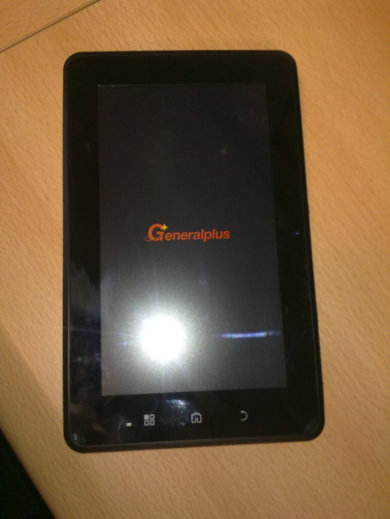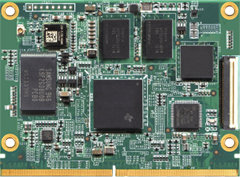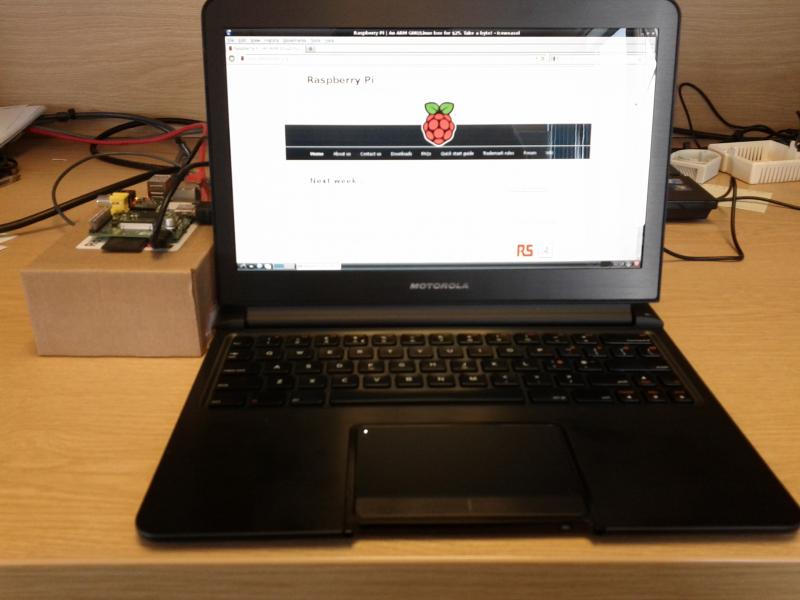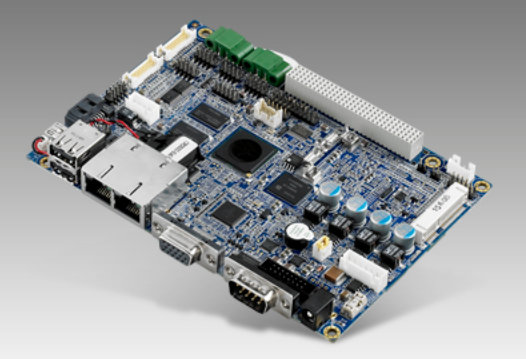I’ve recently come across Eken D70 Tablet which is a typical 7″ Android ICS tablet, except it’s product description shows a Cortex A8 chip called GP33003. After some research, I found that this chipset is provided by GeneralPlus (previously part of Sunplus). GP3300x application processor features a cortex A8 clocked at 1 GHz together with a PowerVR SGX531 GPU, and comes in 216pins LQFP package. This SoC integrates LVDS and HDMI, and the company told me that the GP33XX targets “higher resolution displays, but still keep the lower PCB cost, compared to its current competitors”. It also features an hardware video decoder and encoder (up to 1080p), and can handle a 720p full-duplex video conference. That’s about all the information I could get about the SoC itself. I’ll update this post If I find out more. The company also provides a tablet reference design (GP3300xA Tablet) with the following specifications: […]
TechNexion EDM Modules: Open Software and (somewhat) Open Hardware ARM & x86 CPU Modules
TechNexion, a Taiwanese “embedded solution” company, was present at Computex 2012 showcasing their ARM & x86 CPU Modules and corresponding development kits. The company recently created the EDM Standard, an open hardware and software standard for x86 and ARM Computer on Modules available under the creative commons share alike license. Their EDM modules come in three form factors: EDM Compact: 82 x 60 mm (ARM only) EDM Standard: 82 x 95 mm (ARM and x86) EDM Extended: 82 x 145 mm (x86 only) They have already designed 5 modules based on this standard: EDM-CF-iMX6 EDM Compact Module powered by Freescale i.MX6 (solo, dual or quad) EDM-CT-AM437x EDM Compact Module powered by TI Sitara AM437x (single core Cortex A9) EDM-SF-iMX6 EDM Standard Module with Freescale i.MX6 EDM-ST-AM437x EDM Standard Module with TI Sitara AM437x EDM-XI-QM77 EDM Extended Module with Intel QM77 3rd generation i3/i7 core I could not find information about […]
How To Create and Seed a Torrent in Ubuntu Using Transmission Command Line
You may have a server with limited (free) monthly bandwidth, but yet need to share some large files or files that need to be accessed by a large number of people. Instead of sharing your files via your HTTP server, you can share them via BitTorrent instead in order to hopefully save bandwidth. Here are the steps I followed on Ubuntu 11.10, but they should work with any version of Ubuntu, Debian and Mint. Install transmission client and daemon
|
1 |
sudo apt-get install transmission-cli transmission-daemon |
Create a directory to share your files and .torrent files
|
1 |
mkdir ~/p2p |
Copy your file in that directory and create the torrent file with transmission-cli
|
1 |
transmission-create ubuntu.bin.7z -t udp://tracker.openbittorrent.com:80 |
Start transmission-daemon
|
1 |
transmission-daemon -c ~/p2p |
That’s all your need to do. If you want to monitor transmission remotly via a web interface, you can instead run transmission-daemon as follows: transmission-daemon -c ~/p2p -a public_ip Where public_ip is the public ip of your computer. Alternatively, you could also […]
Make Your Own Raspberry Pi Laptop With a Motorola Lapdock
There is a very interested thread over the Raspberry Pi forums started by user veryevil where he explains how he built a Raspberry Pi laptop based on Motorola Lapdock (normally used with Motorola Atrix smartphone). This is actually a real hack, because the Raspberry Pi still have to sit outside and you need to make custom cables. But the result still looks great, and veryevil claims the system runs Linux smoothly with a resolution of 1366×768 and the battery can last for hours. Some other users have joined the party, and improved on the design with shorter cables. You can check that forum post for detailed pictures of each cables. Motorola Lapdock used to be an expensive piece of equipment, but Raspberry Pi users indicated it’s currently discounted to 69.98 GBP on Amazon UK and I found it for 81 USD on Amazon US (AT&T Version) which makes it somewhat […]
Mitac Unveils ARM Based GFX Server at Computex 2012
MiTAC International announced their first ARM server (MiTAC GFX) based on Marvell ARMADA XP SoC and running Ubuntu 12.04 LTS at Computex 2012, in Taipei. This solution appears to be similar to Dell “Copper” ARM server announced last week, which also uses Marvel ARMADA XP and runs Ubuntu 12.04, except its intended to be a real product rather than just a prototype. The MiTAC GFX with ASX-1 module is intended for deployment as a general purpose server where real estate, efficiency and throughput at a realistic price are key factors and typical applications include web hosting, web browsing, email, chat, social media and networking, etc. Later, MiTAC will introduce an ASX-HP (High Performance) module for compute intensive workloads that can be add to GFX system, and ASX modules featuring 64-bit SoC are under development. MiTAC showcased a GFX System with 64 nodes (that’s 256 Cortex A9 cores) at Computex 2012, […]
How To Let Sudo Insult You When You Type the Wrong Password
This is a completely useless post, but it’s possible to configure sudo to return insults instead of the default error message when you type the wrong password. To enable this feature, edit /etc/sudoers (with visudo for example) and change the line:
|
1 |
Defaults env_reset |
to :
|
1 |
Defaults env_reset,insults |
Open a terminal windows as a normal user, type a command with sudo and input the wrong password. Here are a few examples: $ sudo bash [sudo] password for testman: xxx Are you on drugs? [sudo] password for testman: xxx Maybe if you used more than just two fingers… [sudo] password for testman: xxx Listen, burrito brains, I don’t have time to listen to this trash. [sudo] password for testman: xxx You silly, twisted boy you. [sudo] password for testman: xxx What, what, what, what, what, what, what, what, what, what? [sudo] password for testman: xxx You do that again and see what happens… [sudo] […]
Advantech RSB-4210: Freescale i.MX53 Single Board Computer
Advantech has just launched the RSB-4210, a fanless and heatsink-less RISC Single Board (RSB) powered by Freescale i.MX53 (Cortex A8) with 512 MB DDR3 and 2 GB NAND Flash. This board can operate in industrial temperature range (-40 to 85° C) and targets industrial control, digital signage, HMI/kiosk, medical, and portable applications. Here are the key features of this board: Freescale ARMCortex-A8 i.MX536 @ 800MHz Supports OpenGL ES 2.0 and OpenVG 1.1 hardware accelerators Supports full HD 1080p video decode and HD 720p hardware video encode Video Output LCD support with resolution up to 1920×1080 (default 800×480) via LVDS connector HDMI VGA Touch, UART, I2C, I2S, SPI, GPIO, USB Supports SATA storage interface and CAN-bus for vehicle applications Dimensions – 146 x 102 x 20 mm Power – 9 ~ 24 V DC with 3-watt power consumption Operating temperature – -40 ~ 85° C If you don’t mind about the […]
Zedboard Xilinx Zynq-7000 Community Board is Now Available
Based in March, I wrote about Xilinx Zynq-7000 Extensible Processing Platform (EPP), a SoC comprises of a Dual Cortex A9 and an FPGA, as well as the corresponding development boards and kits: Xilinx Zynq-7000 EPP ZC702 Evaluation Kit based on Zynq-7020 with all the basic components (595 USD). Xilinx Zynq-7000 EPP Video Kit based on Zynq-7020 with all necessary hardware, software and IP components for the development of custom video applications (1195 USD). Zynq-7000 EPP ZedBoard, a low cost development board for the developers community. At the time, the first 2 (expensive) boards were available, but there was little information about the Zedboard. But yesterday evening, I noticed Zedboard website had a lot more information and we now know details about the board and it is even possible to purchase it. Here are the Zedboard specifications: Processor – Xilinx Zynq-7020 Dual ARM Cortex-A9 MPCore @ 677 MHz Memory 512 MB […]









